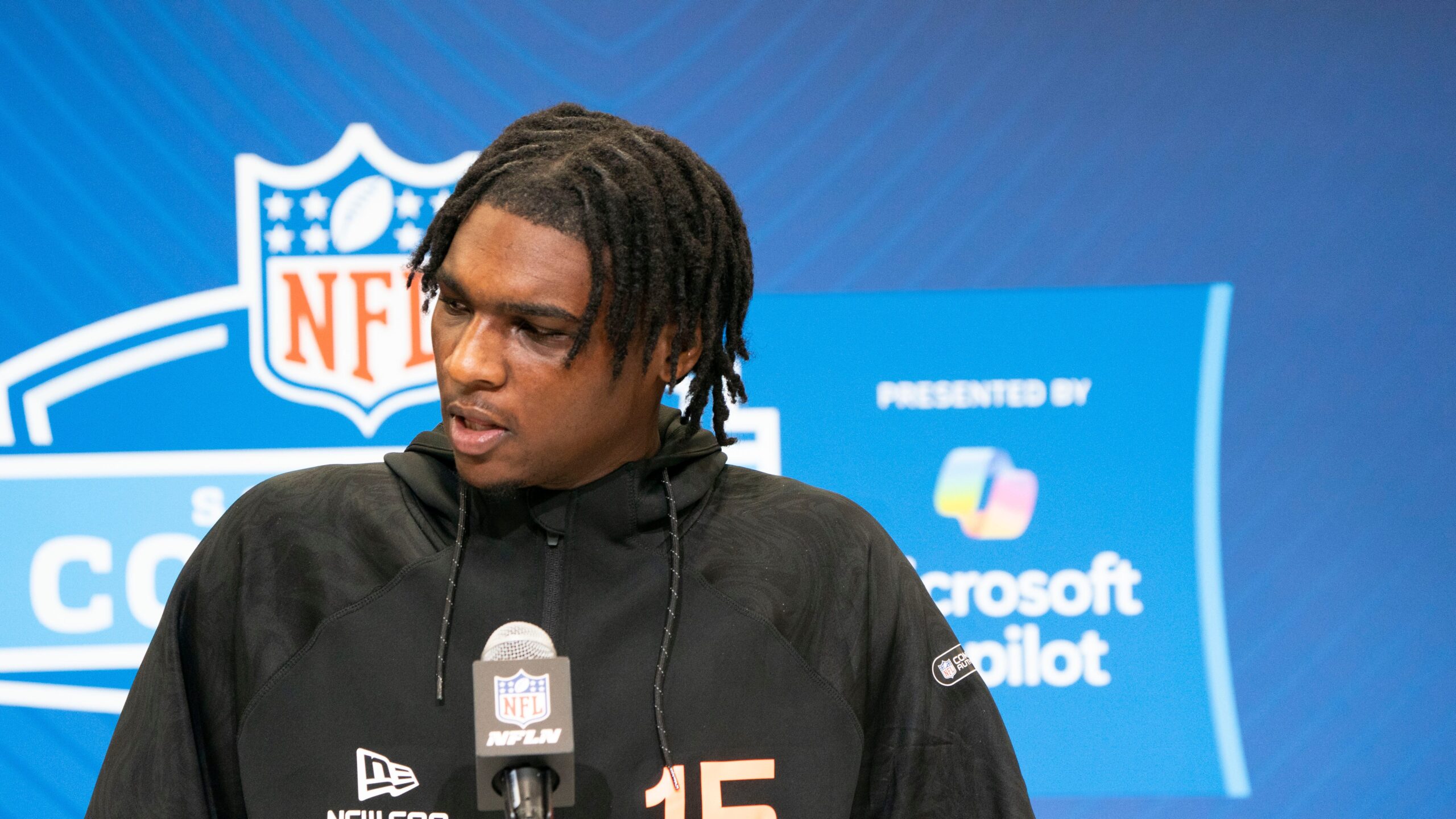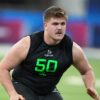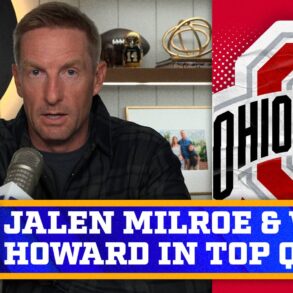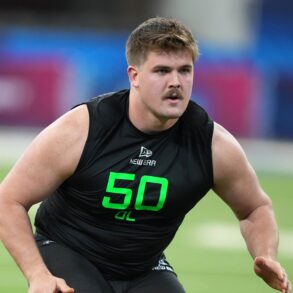Doubling his number of snaps doubles his risk “exposure” as well as his potential for big plays.

Miami QB Cam Ward’s pro day leaves no doubts about No. 1 NFL draft pick
Cam Ward is feeling confident after his pro day performance. He tells the media why he thinks he will be the number one overall draft pick in April.
Any NFL team that picks Travis Hunter in the NFL draft this month will have a unusual puzzle to solve right away:
What exactly do you do with him? Do you seriously consider letting him play almost every single snap on both offense and defense?
That’s what he wants. And that’s what he did in college at Colorado.
But this is the NFL, where old norms die hard and unnecessary risks are mostly avoided.
Is an NFL team really going to increase the injury risk on its $40-million investment by letting him play that many plays and do what other NFL players almost never do?
“That’s my fear… that they don’t know what to do with him in the National Football League,” former NFL quarterback Kordell Stewart told USA TODAY Sports. “You saw what I went through.”
Hunter, a cornerback/receiver, is expected to be a top-five draft pick April 24. All teams with top-five picks have said they were open about Hunter’s proposition to some extent, even if they are not fully convinced. The bigger question is whether the potential payoff is worth the risk − and if Hunter is the very rare player who can shatter old notions about what is possible.
Here’s why teams might resist his request, what teams have said so far and why Hunter might even get his wish.
Travis Hunter wants to play ‘all’ of the snaps
Asked recently how many snaps he wants to play in the NFL, Hunter replied, “All of them if they give me a chance.”
This is not done in the NFL, however. It wasn’t done in college either until Colorado coach Deion Sanders had the vision to turn Hunter loose. “Most coaches in college football won’t allow it… because they can’t fathom it,” Sanders said in December.
The more traditional NFL will be an even harder sell for Hunter. In the mid-20th century, Philadelphia Eagles center/linebacker Chuck Bednarik played both ways on a full-time basis and even played every play in the 1960 NFC championship game. But since then, full-time two-way players have been practically extinct, other than an occasional part-time dalliance with playing both ways.
It’s rare for a reason. NFL teams can afford to pay players to focus on only one side of the ball. A compelling case needs to be made for why there should be an exception.
“It’s the best of the best, and you’re saying you’re the best at two positions?” asked former Buffalo Bills general manager Doug Whaley.
‘How do you protect that investment?’
Letting a player play both sides also invites unnecessary fatigue for the player and worse.
“Doubling the number of snaps doubles the exposure of injury,” said Richard Giller, a renowned sports insurance recovery attorney. “It’s a pretty straightforward thing. The issue then becomes how do you protect that investment?”
Giller recommends that the team that drafts him purchase a temporary total disability insurance policy to cover itself in case of injury.
That itself will require a unique risk calculus, since Hunter’s proposition is so unusual.
At Colorado last season, he led major college football with 1,483 plays − 714 on offense, 748 on defense and 21 on special teams, plus 65 more that were called back due to penalty, according to CU. Since then, he’s been preparing for the draft and soon will join a team to prepare for a 17-game regular season in the NFL. That’s not much of a break for a high-mileage player who measures at 6-feet, 188 pounds.
At that rate, “How long can this guy last?” asked Whaley, who recently has worked in player personnel with the United Football League.
But what if Hunter really is the best cornerback on your team and one of your top wide receivers?
And what if his two-way play might combine with his big smile to make him the kind of beloved generational superstar some NFL cities haven’t seen in decades, if ever?
‘Figure it out’
Kordell Stewart, a former Colorado quarterback, has seen this sort of thing before. After he was drafted by the Pittsburgh Steelers in 1995, he didn’t fit the traditional NFL mold of what a quarterback usually looked like back then – a white, drop-back passer.
So they moved him around – putting him at quarterback, receiver, running back and even a little bit as punter. Unlike Hunter, Stewart didn’t play defense and at least could take a break when the offense was off the field. At the same time, he helped the NFL see what was not just possible but also beneficial. He was ahead of his time as a Black NFL quarterback with mobility – now a common sight.
“It was no way possible I could catch the ball that good and play quarterback,” Stewart said of the NFL thinking back then.
Stewart related that experience to Hunter’s future in a conversation with USA TODAY Sports in December, shortly before Hunter won the Heisman Trophy.
“There is no other player like him,” Stewart said. “There isn’t. I don’t care. Just leave him alone. Bring him in and play him. Figure it out.”
Most-decorated college player in a single season
Stewart estimated Hunter is better than the second and third receivers of most NFL teams and better than the majority of the league’s “lockdown” cornerbacks.
“When you look at the game and how traditional it is in the sense of how coaches coach… I hope he finds a coach that’s as transparent as possible to say, ‘We’re gonna use this talent on our football field to help us win,’ ” Stewart said.
Deion Sanders saw that potential after playing both ways himself in the NFL to a smaller extent. “He allowed him to be Travis Hunter,” Stewart said.
And then Hunter became the most-decorated player in college football history for a single season with eight major college football awards, according to CU.
Will NFL teams see the same potential?
Before the NFL draft, teams generally aren’t inclined to share their true feelings about a prospect. Some still gave a glimpse of what they thought about Hunter’s wishes.
∎ Jacksonville Jaguars head coach Liam Coen recently told Action Sports Jax that the team that picks Hunter needs to be “fluid” and explained why it would take a small village of sorts to fulfill Hunter’s wish. “Patience” among coaches also could be necessary if tensions rise over Hunter’s services.
“That has to be an organizational buy-in from the coaches, the strength staff, the athletic training, sports performance,” Coen said. “Everybody has to be involved, as well as the coaches… in having patience with each side of the ball, because you really don’t want to kind of put him in a box.”
∎ The Jaguars have the No. 5 pick, behind the Tennessee Titans at No. 1, Cleveland Browns at No. 2, New York Giants at No. 3 and New England Patriots at No. 4.
Patriots coach Mike Vrabel seemed to tap the brakes on the idea recently.
“We’ve never seen a player, you know, necessary do it,” Vrabel told reporters. “I think there are some things he can improve on by probably concentrating… just on one position, but never going to put any restrictions on Travis or any player.”
∎ Some teams also want him to concentrate on one side of the ball at first but differ on which. Titans head coach Brian Callahan said it’s “very realistic” Hunter could play both ways but said they’d start him at cornerback before working him at times at receiver.
∎ By contrast, the Browns see him primarily as a receiver at first but acknowledge Hunter is a “unicorn” who could do both at a high level, according to general manager Andrew Berry.
“In terms of Travis Hunter, cornerback or receiver, the answer’s yes,” Berry said at the NFL scouting combine this year.
How does Travis Hunter see it?
Even if Hunter plays both ways on a regular basis, it won’t open the floodgates for players to do what he does.
“There’s not enough people that have that ability,” Whaley said.
As Sanders has said of Hunter: “He is Him.” And this is a unicorn moment. Will an NFL team properly take advantage of it?
Sanders and Bo Jackson are sports icons because they played pro football and baseball at the highest level. Hunter could reach the same status in an NFL city if he plays both ways in the highest level of football.
He’s been wanting this for a long time and has expected some pushback from NFL teams.
“Yeah, because it’s never been done, so I understand that,” Hunter told reporters late last year. “They don’t want me to be a high risk, you know. If I go top pick, they don’t want their top pick to go down too early.”
He’s not thinking about risk, however. He’s thinking about reward.
“I believe I can do it,” he said. “Nobody has stopped me from doing it this far.”
More recently, he was asked how he wants NFL commissioner Roger Goodell to announce his job title when he’s drafted. Wide receiver or defensive back?
“He better say wide receiver and DB,” Hunter said.
Follow reporter Brent Schrotenboer @Schrotenboer. Email: bschrotenb@usatoday.com
This post was originally published on this site be sure to check out more of their content.







